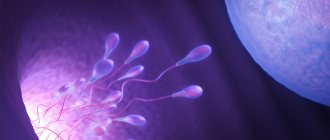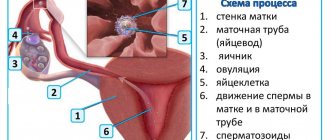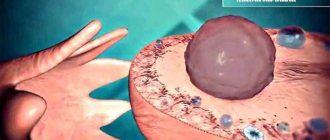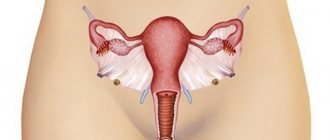≡ Home → Endometrium → Endometriosis →
Endometriosis is a chronic disease in which cells from the lining of the uterus end up outside the uterus. The pathology is detected in women of reproductive age and is one of the most common causes of infertility. Without treatment, endometriosis progresses and interferes with conception and pregnancy.
Pregnancy with endometriosis is possible, but the chances are low. Without special therapy, the path to motherhood drags on for many years. After treatment, a woman can safely conceive, carry and give birth to a healthy child. How pathology affects pregnancy, and what treatment methods can help achieve the long-awaited result, we will consider in more detail in the article.
Pregnancy and endometriosis: a few facts
It is important to know:
- Endometriosis is detected mainly during reproductive age - at the time when a woman plans to become a mother;
- Pathology is found in 5-10% of women aged 18-45 years;
- When performing diagnostic laparoscopy for infertility, endometriosis is detected in 19-50% of cases (according to various authors);
Laparoscopic diagnosis of infertility often shows that its cause is endometriosis.
- Up to 30% of women with endometriosis turn to assisted reproductive technologies.
All this indicates the relevance of the problem and requires careful attention to it. You should not think that the disease is not dangerous and can be left to chance. If the situation is not resolved in time, you can forget about the desire to become a mother.
What contributes to the development of endometriosis
At the moment, there are no clear reasons for the development of the disease. Scientists are still trying to figure out what can trigger the process of pathological changes in the fallopian tubes. But several of the most likely reasons can still be identified:
- Hormonal imbalance
- Weakened immunity due to concomitant diseases
- Nervous shock and stress
- Unfavorable environmental conditions
- Genetic predisposition
It is worth saying that, despite the fact that the disease most often occurs during childbearing years, medicine has recorded endometriosis of the right and left ovaries in immature girls who have never menstruated, as well as in women over 45 years of age. This indicates that the disease is not fully understood and any woman who does not visit a doctor and does not monitor her health is at risk.
How endometriosis interferes with conceiving a child
It is impossible to say unequivocally which processes affect the functioning of a woman’s reproductive system. Scientists have identified several factors that prevent the conception of a child and lead to infertility with endometriosis:
- Hormonal changes. Endometriotic lesions occur against the background of excessive secretion of estrogen and a relative deficiency of progesterone. Over time, heterotopias acquire the ability to grow autonomously and begin to synthesize hormones. Local hyperestrogenism prevents the full functioning of the ovaries, inhibits the maturation of follicles and interferes with ovulation. Excess estrogen also prevents the endometrium from preparing to accept the embryo and implantation;
Hormonal imbalance may be one of the reasons for the development of endometriosis.
- Immunological failure. The subtle mechanisms of the immune system are still being studied. So far, scientists have been able to find out that against the background of endometriosis, the activity of the T-link decreases and the production of B-lymphocytes increases. The natural processes of cell change are disrupted, apoptosis – their programmed death – does not start. The cells continue to grow uncontrollably and invade surrounding tissue. In this way, endometriosis is similar to a tumor process;
- Decreased ovarian reserve. When the process is localized in the ovaries, the functional tissue of the organ is gradually displaced. The cyst grows - healthy cells die, the supply of follicles decreases. No follicles - no ovulation. Premature menopause develops, and conceiving a child becomes impossible;
- Maturation of defective eggs. Immunological changes against the background of pathology interfere with the full development of follicles. Inferior oocytes are formed that are not capable of fertilization;
- Chronic inflammatory process. Aseptic inflammation is supported by functioning endometrioid foci. Against this background, the work of the ovaries and fallopian tubes is disrupted, and pregnancy does not occur;
- Adhesive process. Chronic inflammation in endometriosis leads to the appearance of adhesions. Rough cords block the lumen of the fallopian tubes and envelop the ovaries. A mature egg cannot meet a sperm, and conception does not occur;
- Low sensitivity to progesterone. Endometriosis changes the structure of the uterine lining. Receptors lose sensitivity to progesterone. The endometrium does not fully mature in the second phase of the cycle. There are no conditions for implantation of the fertilized egg - and the pregnancy is terminated in the early stages;
- Negative effect on sperm. With endometriosis, the composition of cervical mucus and peritoneal fluid (in the pelvic cavity) changes. Sperm become immobile, cannot reach the egg, and die too quickly.
The composition of cervical mucus, altered due to endometriosis, leads to rapid death of sperm, which is one of the causes of infertility.
It is important to know
Endometriosis affects all aspects of conception and gestation. It prevents ovulation, prevents the meeting of the egg and sperm, and prevents the embryo from passing through the fallopian tubes and implanting into the uterine cavity. The longer the disease lasts, the lower the chances of a favorable outcome.
It is assumed that endometriosis can cause the following conditions:
- Ectopic pregnancy. If the fallopian tubes are poorly passed, the fertilized egg gets stuck in them and is implanted into the wall. Such a pregnancy is doomed - the embryo dies at 4-6 weeks;
- Regressive (frozen, non-developing) pregnancy. With endometriosis, the process of implantation of the fertilized egg into the uterine wall is disrupted. Indirectly, this can interfere with the development of the embryo.
Degrees of the disease
Endometriosis is divided into 4 stages:
1. Mild form of the disease. Unfortunately, it is asymptomatic, so you should definitely visit a gynecologist regularly. During the examination, the doctor will not send you for an ultrasound if he does not see any abnormalities, but you can play it safe and take a referral to rule out the presence of the disease.
2. Endometriosis of the second degree is already more difficult. The patient feels pain in the place where the epithelium has taken root and is growing. Often, you can quickly get rid of the disease at this stage by taking special medications.
It happens that the disease progresses quickly, in which case surgery is performed.
At the second stage of the disease, the amount of menstrual flow increases significantly. Also, there is spotting between periods.
3. The third stage of endometriosis is very serious. New areas of tissue appear on organs, and old ones increase in size. Accordingly, the pain becomes stronger. At this stage, reproductive and other organs are affected.
At this stage of the disease, surgery is recommended, since oral medications do not help.
4. Severe form of the disease. In this case, the woman’s reproductive system is completely affected, this also applies to the abdominal organs. Fusion often occurs. The vagina and anus are more susceptible to this process. If left untreated, death is possible.
Factors influencing conception of a child
The likelihood of pregnancy depends on the following factors:
- Severity. In the initial stages of the disease, you can still conceive a child on your own. In advanced cases, even assisted reproductive technologies do not always cope;
- Prevalence of the process. The more organs affected by heterotopias, the lower the chances of a favorable outcome;
- Concomitant pathology. If endometriosis occurs together with fibroids or endometrial hyperplasia, it is more difficult to get pregnant. Often the pathology is detected against the background of endocrine disorders (obesity, hypothyroidism), which also complicates pregnancy;
If endometriosis is accompanied by other pathologies, such as uterine fibroids, this significantly reduces the chances of getting pregnant.
- Woman's age. After 40 years, the supply of follicles decreases, and it is difficult even for a healthy woman to conceive a child.
It is important to know
Endometriosis is not an indication for abortion. If a woman managed to conceive a child due to pathology, she should try to maintain the pregnancy. There may not be a second chance.
It is also useful to read: Use of Buserelin Long (Depot) for endometriosis
Summarizing
It has been established that a woman suffering from endometriosis has the opportunity to become pregnant and bear a healthy baby . With the onset of pregnancy, endometriosis does not pose any danger, except for the risk of miscarriage in the first trimester. But as soon as the placenta begins to fully function, the baby is not in danger. It is believed that with endometriosis it is useful to get pregnant - the hormonal levels change, and the pathology goes away on its own.
When planning a pregnancy, it is advisable to undergo examination for the presence of endometriosis and other pathologies of the reproductive organs, because it is endometriosis that hinders the ability to become pregnant and safely carry a baby. If a patient is diagnosed with endometriosis, it is advised to undergo treatment for normal intrauterine development of the fetus. The earlier the pathology is detected, the greater the woman’s chances of becoming pregnant.
Therefore, at the first alarming symptoms reminiscent of signs of endometriosis, you need to contact an obstetrician-gynecologist.
What forms of endometriosis are dangerous?
The probability of successful conception and bearing a child depends on the location of the pathological process:
- With adenomyosis (endometriosis of the uterus), the conception of a child is prevented by immunological and hormonal imbalance. Often pregnancy is terminated in the early stages as a result of defective implantation;
- With ovarian endometriosis, the ovarian reserve decreases. Without ovulation, conceiving a child is impossible;
- When the fallopian tubes, peritoneum and pelvic tissue are damaged, an adhesive process develops, interfering with fertilization. The risk of ectopic pregnancy increases;
- Heterotopias on the cervix and vagina usually do not interfere with conception and pregnancy.
The likelihood of a successful outcome is lower when external and internal endometriosis is simultaneously detected.
When does it occur
There is no exact answer. Some doctors adhere to the theory that such a disease develops against the background of complicated childbirth or miscarriages. Pieces of the endometrium do not completely leave the uterine area and remain inside the reproductive organs. Thus, the endometrium attaches to the ovaries, tubes or vagina and begins to grow.
Proponents of another theory are convinced that such a disease is transmitted only by inheritance. If a girl’s grandmother or mother had this disease, then she also has a predisposition to it.
To identify attached and growing tissues in the body (not only on the reproductive organs), ultrasound and laparoscopy are prescribed.
The course of pregnancy and childbirth with endometriosis
Even if you manage to get pregnant with endometriosis, fetal development does not always go well. Against the background of pathology, the risk of complications increases:
- Spontaneous miscarriage (before 22 weeks) or premature birth (after 22 weeks). In the early stages, the cause of termination of pregnancy is defective implantation, in the later stages – placental insufficiency;
- Preeclampsia. Immunological and hormonal disorders prevent a woman’s body from adapting to pregnancy. The risk of developing preeclampsia, a serious complication in which blood pressure rises and kidney and liver function suffers, increases;
- Placental insufficiency. Incomplete implantation, insufficient blood flow in the uterus - all this interferes with the development of the placenta. The fetus suffers: it does not receive oxygen and nutrients in the required volume. Chronic hypoxia of the fetus develops, and its development may be delayed;
- Placenta previa. With internal endometriosis, the fertilized egg is often attached too low and blocks the internal os. This condition threatens bleeding during pregnancy and interferes with the natural course of labor.
Placenta previa prevents a woman from giving birth on her own.
All these processes can be tracked if you undergo screenings on time and regularly visit your doctor. If complications are identified, their correction is indicated taking into account the duration of pregnancy.
Will surgery help you get pregnant?
Modern medicine is impossible without surgical operations, which are divided into conservative interventions and radical interventions. Most often they are combined and used as the most gentle method.
For endometriosis, laparoscopy is most often performed, during which the tumors are cauterized with a special laser. If the disease is accompanied by severe complications, the doctor uses the laparotomy method - cutting the abdominal wall. After surgery, the patient needs to take a course of medication and undergo physical therapy to consolidate the positive result. In general, the operation relieves unpleasant painful sensations, stops the inflammatory process, restores reproductive function, which allows the patient to become pregnant.
Childbirth with endometriosis
Unattended childbirth with endometriosis is possible:
- If the condition of the fetus is not disturbed: there are no signs of intrauterine hypoxia;
- If there are conditions for natural childbirth: the fetus is located longitudinally with its head down, the mother’s pelvis is not narrowed;
- If there are no contraindications on the part of the woman: severe somatic and gynecological pathology.
Complications may develop during childbirth:
- Uterine bleeding due to placenta previa and other conditions;
- Abnormalities of labor: weakness or incoordination of contractions;
- Violation of the placenta in the third stage of labor.
If indicated, a planned caesarean section is performed at 37-41 weeks. Typically, doctors try to deliver a woman before 40 weeks to reduce the risk of complications.
In natural childbirth, you wait until contractions begin. Stimulation of labor is indicated for post-term pregnancy.
How pregnancy affects the disease
After conceiving a child, hormonal levels change. The production of progesterone, a hormone that ensures successful gestation, increases. Under the influence of hormones, endometriosis lesions decrease in size and even disappear completely. During pregnancy, the disease usually does not remind you of itself.
Pregnancy and lactation are the best natural protection against the progression of endometriosis. While a woman is carrying a child and feeding him breast milk, the disease does not develop. The growth of endometriosis foci begins after the cycle is restored. In non-breastfeeding women, this occurs 8-12 weeks after birth. During lactation, menstruation may not occur for 6-12 months or longer. There are cases when the menstrual cycle was restored after 1.5-2 years and later - only after the end of lactation. As long as menstruation does not occur, a woman is protected from the development of endometriosis.
On a note
If a woman is not planning a pregnancy and is not breastfeeding, she can take combined oral contraceptives. COCs create a hormonal background in the body similar to pregnancy and protect against the progression of endometriosis.
Pregnancy suppresses the growth of heterotopias for 1-2 years. Relapse of the disease rarely occurs earlier than after 12 months. The progression of the disease can be tracked by the return of its symptoms. Many women note that after childbirth, signs of pathology decrease, the menstrual cycle normalizes, and pain goes away. Menstruation becomes shorter and more abundant, and the general condition improves.
As a rule, after childbirth, the development of endometriosis stops.
Diagnostics
To make a correct diagnosis, you need to undergo a full examination, which will be prescribed by your doctor.
Diagnostic features
Since this disease can develop without the manifestation of any special symptoms, a woman may not even be aware of its occurrence.
That is why it is very important to conduct regular examinations with a gynecologist and undergo an ultrasound examination from time to time. Diagnosing this disease is not easy. This is due to the fact that the pattern of its development is quite similar to the manifestations of other diseases. Therefore, if a specialist suspects the formation of this disease, he will most likely prescribe a comprehensive analysis. As a rule, it is prescribed:
- Ultrasound diagnostics.
- Gynecological examination.
- Hysteroscopy.
- Laparoscopy.
Possible complications
One of the most severe consequences of this disease is infertility.
As a rule, its occurrence is observed in 60% of women who have suffered from the disease. In addition, if the disease causes compression of the neural tubes, neurological disorders may occur.
Quite frequent bleeding, which characterizes this disease, causes the development of anemia. It greatly disturbs a woman, because it is accompanied by a number of very unpleasant phenomena.
One of the most dangerous complications is malignancy. This word, unfamiliar to many women, means the appearance of a malignant formation at the site of the disease.
Treatment during pregnancy
There is no treatment for endometriosis during pregnancy. There are explanations for this:
- Some hormonal drugs used in the treatment of the disease are dangerous to the fetus;
- Surgical treatment is not performed - the risk of miscarriage after surgery is too high. The exception is large endometrioid ovarian cysts (5-6 cm or more). The cyst can be removed laparoscopically in the second trimester;
- During gestation, endometriosis lesions regress on their own, and additional intervention is not necessary.
Treatment of endometriosis continues after the birth of the child and completion of lactation. Before starting therapy, you need to be examined again to assess the dynamics of the disease after childbirth.
IVF: is there a chance?
In vitro fertilization is indicated if it is not possible to conceive a child naturally:
- With external genital endometriosis with the development of adhesions and obstruction of the fallopian tubes;
- With a combination of external and internal endometriosis (adenomyosis);
- With a decrease in ovarian reserve in late reproductive age (after 35 years);
- With a combination of female and male infertility.
After numerous unsuccessful attempts to become pregnant naturally, a woman may be offered in vitro fertilization.
Typically, patients are referred for IVF after a year of unsuccessful attempts to treat endometriosis. But if a woman is already 40 years old, the doctor can immediately suggest in vitro fertilization. At this age there is no time to waste. The ovarian reserve decreases every year, and the chances of conceiving a child decrease.
It is also useful to read: Use of contraceptives for endometriosis
Difficulties of IVF with endometriosis:
- It is not clear whether small endometrioid cysts need to be removed. On the one hand, formations up to 3 cm in size do not interfere with the conception and bearing of a child. On the other hand, such cysts reduce the chances of successful IVF. But ovarian surgery is always a risk. It can lead to a decrease in ovarian reserve;
- Against the background of endometriosis, it is not always possible to successfully stimulate the ovaries and obtain a sufficient number of eggs (more than 5). Many women with a long course of the disease have a reduced ovarian reserve;
- Receiving a large number of eggs after stimulation does not guarantee the success of IVF. Against the background of endometriosis, the quality of oocytes deteriorates, and not all of them are suitable for fertilization;
- Endometriosis of the uterus interferes with implantation - the introduction of the fertilized egg into the wall of the uterus. Even if a child is successfully conceived, the risk of miscarriage is high.
On a note
If you have endometriosis, you should not postpone motherhood for a long time. Against the background of pathology, the ovarian reserve decreases, and not everyone is able to give birth to a child after 35-40 years. But if by the age of 35 a woman has not decided to become a mother, she can freeze her eggs and use them later in the IVF program.
IVF with a decrease in ovarian reserve is possible with donor eggs. For fertilization, the oocytes of the donor woman and the sperm of the partner are used. If there is concomitant male infertility, you can take donor sperm.
Prevention
For prevention you need to follow the rules:
- do not skip gynecological examinations with a doctor;
- if you have suspicious symptoms, you should immediately go to the hospital;
- promptly treat diseases of the reproductive system and other infectious and inflammatory processes;
- maintain intimate hygiene.
It is advisable to plan pregnancy in order to prevent and eliminate pathologies and complications. If endometriosis is detected already during gestation, then it is imperative to constantly be under medical supervision.
ONLINE REGISTRATION at the DIANA clinic
You can sign up by calling the toll-free phone number 8-800-707-15-60 or filling out the contact form. In this case, we will contact you ourselves.
If you find an error, please select a piece of text and press Ctrl+Enter
Planning pregnancy with pathology
Sometimes pregnancy with endometriosis occurs spontaneously, and then all that remains is to register with a gynecologist. But more often, before conceiving a child, a woman needs to undergo examination and treatment. You should not put off resolving this issue for long. Sometimes several years pass from the moment of diagnosis to a positive result.
When planning a pregnancy you need:
- Make an accurate diagnosis - determine the localization of the process and the stage of its development. For this purpose, ultrasound of the pelvic organs, MRI, diagnostic laparoscopy or hysteroscopy, colposcopy are performed - according to indications;
When planning a pregnancy, it is necessary to undergo an ultrasound examination to identify possible pathologies that may interfere with the normal course of pregnancy and childbirth.
- Assess the ovarian reserve: donate blood for hormones (AMH, FSH), do an ultrasound of the pelvic organs to determine the number of antral follicles and the volume of the ovaries. If the ovarian reserve is reduced, do not plan long-term therapy;
- Decide on patient management tactics. For minor forms of endometriosis, you can plan pregnancy immediately or after a short course of hormonal therapy. If the process is widespread and deep, perform surgical treatment;
- Evaluate the results of the treatment. Plan a pregnancy in a natural cycle or through IVF.
Medication preparation
The goal of conservative treatment is to reduce the size of endometrioid lesions and inhibit their growth. For this purpose the following are assigned:
- Gonadotropin-releasing hormone agonists (Buserelin, Lucrin, Diferelin). The course of therapy is 3-6 months under the cover of estrogen. They reduce the level of sex hormones before menopause, creating an artificial menopause. Used before and after surgical treatment;
- Gestagens (Visanne, Duphaston). The course of treatment is 3-9 months. Usually prescribed as the main method of treatment or after surgery;
- Combined oral contraceptives (Janine, Silhouette). The course of therapy is from three months. If a woman is not planning a pregnancy, she can take COCs for quite a long time - until the onset of natural menopause.
Combined oral contraceptives are used in the drug treatment of endometriosis.
You need to plan to conceive a child immediately after stopping the drug. You don’t have to wait long – the effect of hormonal therapy lasts for 1-2 years. Then the disease may return and therapy will have to be repeated.
Surgery
Laparoscopic intervention is indicated for external endometriosis. If there are lesions on the ovaries, fallopian tubes, or peritoneum, they should be removed. Heterotopias are excised or coagulated under visual control. Endometrioid cysts are removed. Abdominal surgery is not performed - the risk of formation of adhesions and spread of endometrioid cells throughout the pelvic organs is too high.
For uterine endometriosis, surgical treatment is not performed during reproductive age. If the process spreads to the outer layer, there is only one way out - remove the uterus. But after this, the woman will not be able to give birth to a child, so in terms of treating infertility, this method does not make sense.
You can usually plan a pregnancy 3-6 months after laparoscopy. The exact timing depends on the type of intervention, the woman’s age, and the course of the postoperative period.
On a note
Folk remedies (treatment with herbs and bee products), hirudotherapy, acupuncture and other methods of alternative medicine do not affect the course of endometriosis and do not help in the fight against infertility.
What does the disease lead to?
First of all, endometriosis affects the uterus, as well as the nearest genital organs. Endometrial tissue is sensitive to hormone cells, so the following changes occur in distant areas covered with mucous membrane:
- Endometrial tissue in the uterus grows and becomes dense - this is due to the release of estrogen cells in the first days of the menstrual period.
- The second half of the period is characterized by the influence of progesterone, which destroys the newly formed layer. This process is accompanied by inflammation and bleeding.
Thus, endometriosis of the uterus leads to the formation of cysts, improper functioning of the organs of the reproductive system, and in severe cases jeopardizes the possibility of conceiving a fetus and the normal course of pregnancy.
Endometriosis and pregnancy after 40 years: important aspects
Endometriosis is a disease that steadily progresses. By the age of 40, without treatment, deep and widespread forms are observed, which are difficult to cope with using conservative methods. Adhesions, chronic inflammation, hormonal and immune imbalance - all this interferes with ovulation, impedes fertilization, implantation and gestation.
A decrease in ovarian reserve is another problem for women over 40 years of age. At this age, the supply of follicles decreases even in healthy women. With endometriosis, the ovaries already suffer, anovulatory cycles are observed, and it is difficult to conceive a child. The older the woman, the more difficult it will be to cope with the disease and cure infertility. Sometimes even assisted reproductive technologies fail.
Interesting video about innovative methods of treating infertility due to endometriosis
About the dynamics of the development of endometriosis during pregnancy
Symptoms
At the beginning, the disease is asymptomatic and can only be diagnosed during a gynecological examination. But sometimes slight changes in a woman’s well-being may be observed:
- pain before and after menstruation;
- during intimacy, severe discomfort up to the impossibility of penetration;
- menstruation too heavy;
- discomfort during urination;
- White liquid is sometimes released from the mammary glands;
- infertility diagnosed
During menstruation, all symptoms become greatly aggravated, the affected area increases in size. Therefore, at the first suspicious signs, you need to contact a gynecologist; in the early stages, endometriosis can be eliminated, but if therapy is ignored, drastic measures may be required, including removal of the uterus.











